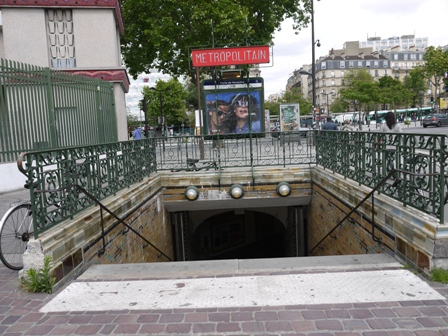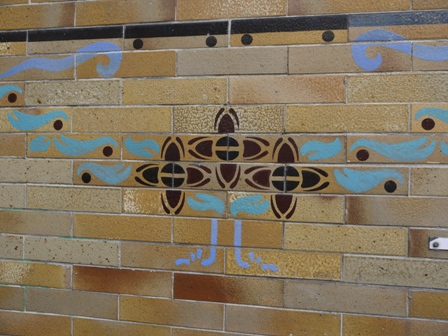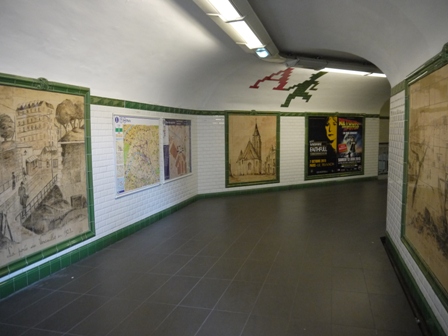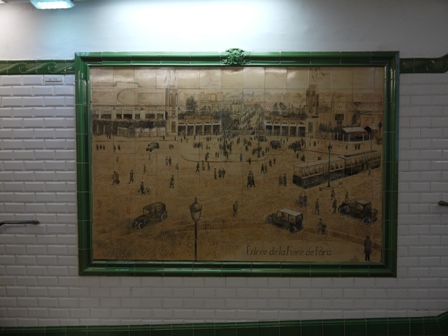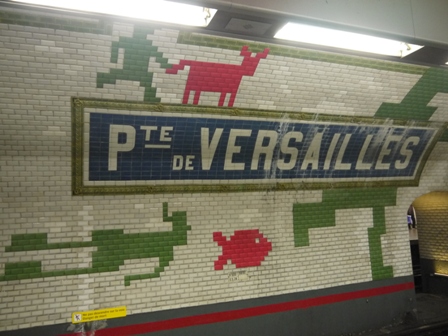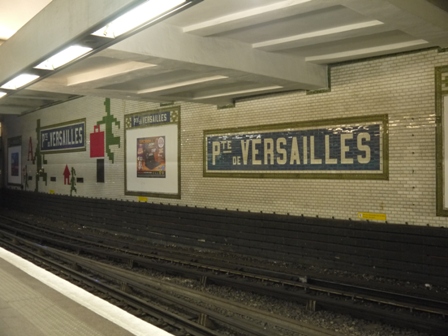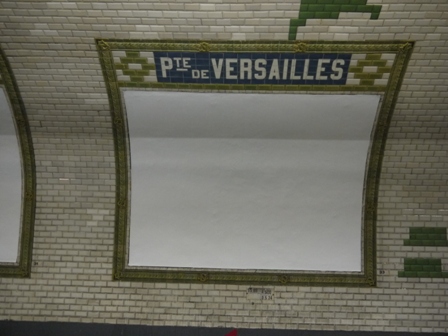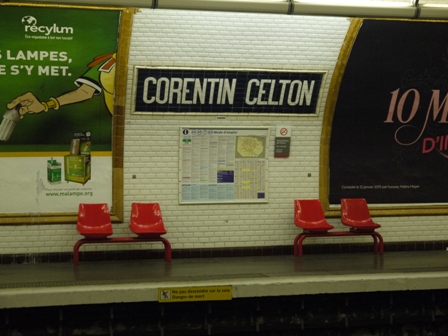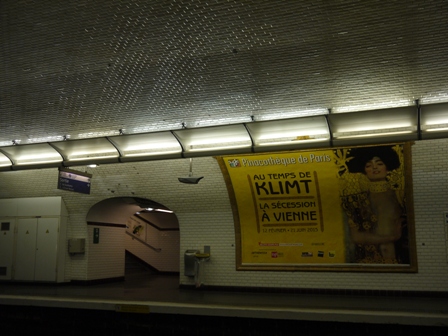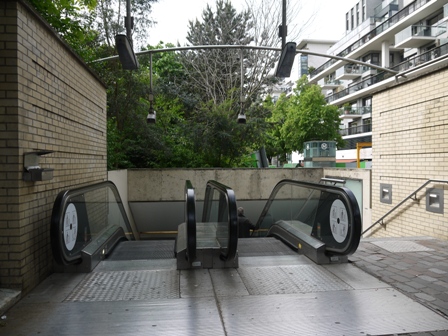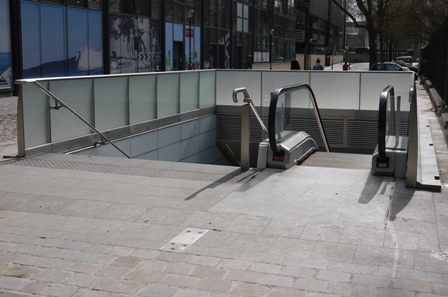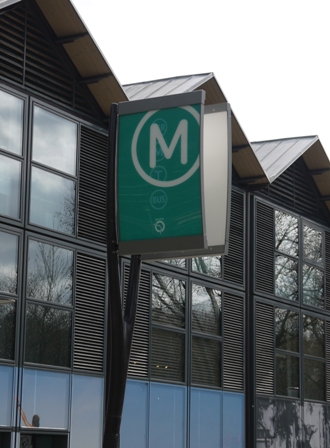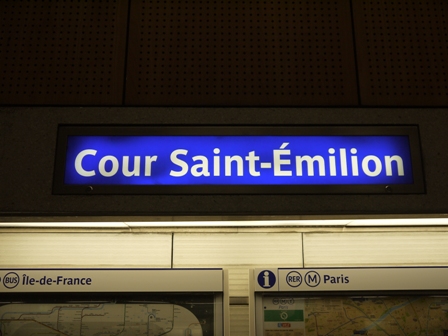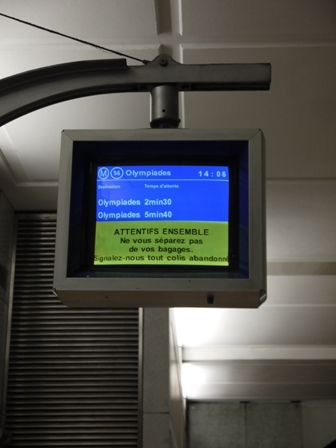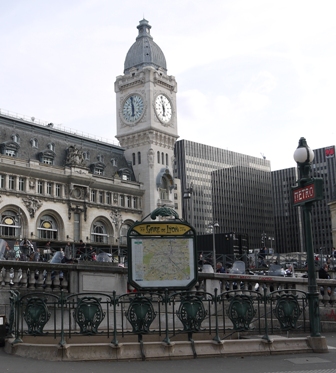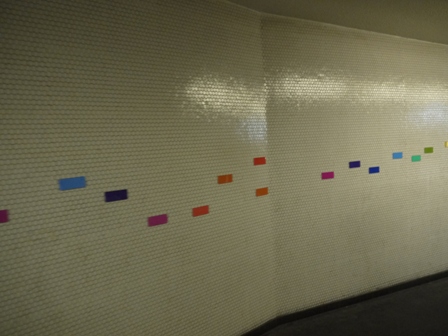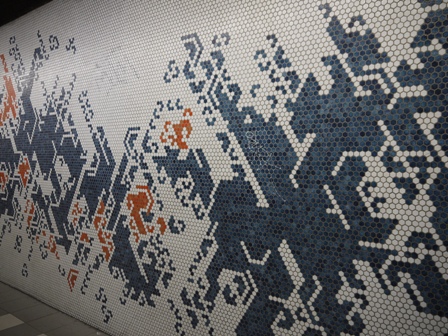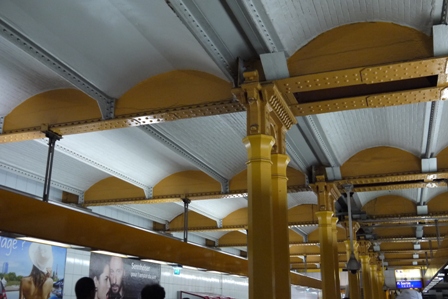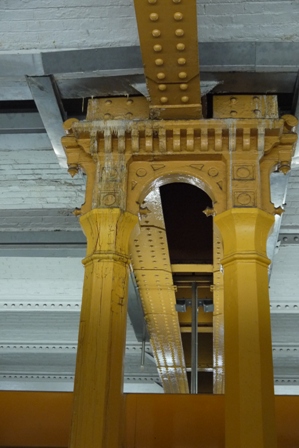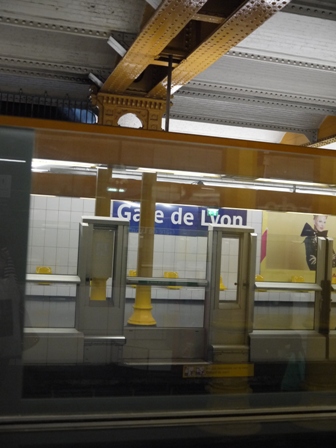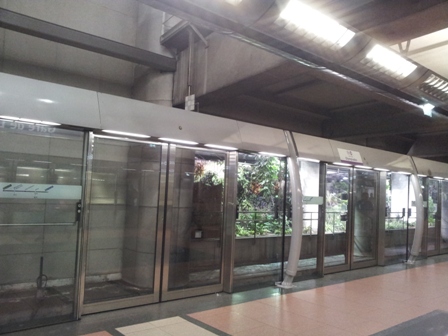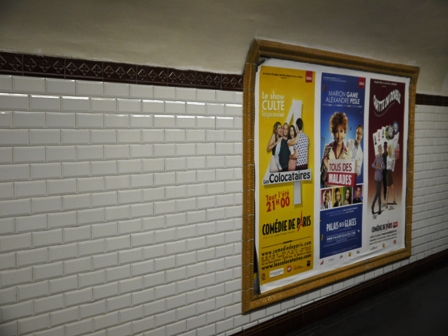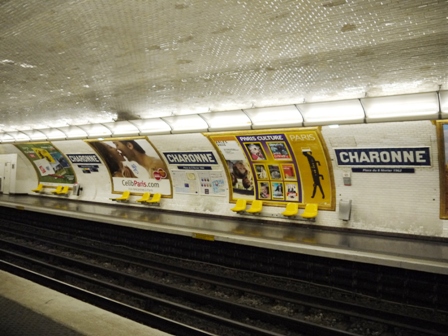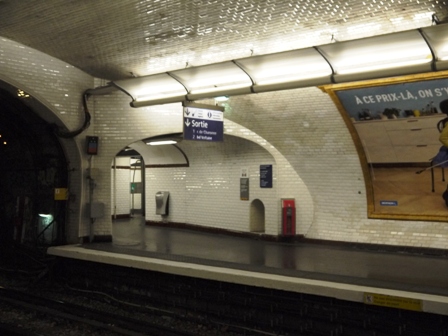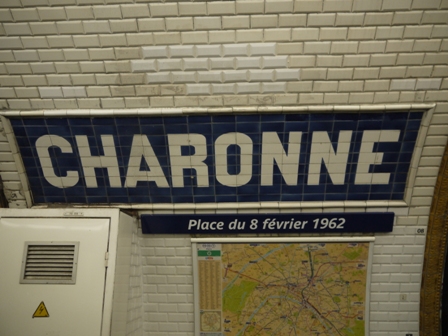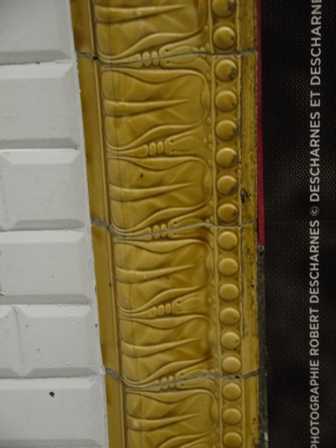- Details
The station opened on 5 November 1910.
Porte de Versailles is situated in the 15th arrondissement, close to the exhibition centre. It takes its name from the fortification of the former city wall around Paris.
It is served by the metro line 12 and connects with the tram lines T3A and T2.
The platforms have been replaced in the early 1930s when the line was extended to Mairie d'Issy.
The station has three platforms and the possibility to park a number of metros in the tunnels.
One of the entrances. It is surrounded by a green fence with swirly panels fixed on a low tiled wall.
Behind it is a station panel with rounded corners in a green metal frame.
Inside it are an advertising poster on one side and a map of the metro system on the other.
A very thick white area with raised circles has been put in front of the stairs.
Handrails are fixed on the left and right walls.
Three small round white lights in green casings have been placed on the backwall at ground level.
A large, rectangular red sign in a green metal frame hangs from two green curved poles. Parts have been removed from the red to reveal the word METROPOLITAIN in white letters.
Behind it is a station panel with rounded corners in a green metal frame.
Inside it are an advertising poster on one side and a map of the metro system on the other.
The walls of the entrance are tiled with light brown long rectangular tiles.
A pattern three brown flowers, light blue swirls and small dark brown circles has been stencilled on them.
In the corridor are several green ceramic frames with drawings of the area on light brown ceramic tiles of an earlier era.
The top of the frames are linked with green border tiles with patterned waves.
The floor is tiled in large rectangular brown tiles.
The green ceramic frame is made of curved tiles. On the top centre is a tile with the Nord-Sud logo - the letters N and S intertwined with a ribbon.
Inside the frame is a painted scene of front of the Foire de Paris during the 1920s in brown tones on standard square tiles.
The walls are tiled with white rectangular tiles with a raised centre.
The mezzanine floor over the tracks.
Next to the map of the network are the stairs down towards Mairie d'Issy. Further along are the metal exit doors leading from the other platform (direction Paris).
The signage is very large. The name of the station is stencilled in capitals on rectangular, flat blue tiles. The inner frame is made of plain white ceramic tiles.
The outer frame is made of green ceramic tiles with an olive branch pattern and Nord-Sud logos.
On the wall are painted tiles showing some of the exhibitions taking place close by during the year: a man and a cow - the agricultural show, a man snorkling - the holiday exhibition.
The vaulted ceiling is tiled. The floor is tiled in brown tiles.
The red cylinder can serve both as lighting and a projector.
Occasionally small exhibitions of rolling stock are brought here and their history is shown there.
Exit to the exhibition centre and the T3. Additional signage in the centre with the station name in upper and lower case.
The lights are in two stainless steel box running along the edges of the platform.
Red metal, half-bowl seats with a smiley slit have been placed on a grey base in the centre of the platform.
Metros towards Issy-les-Moulineaux sometimes stop here and passengers are required to take the next metro on the facing platform.
The ceiling of this platform is supported by steel beams. It is painted white.
The walls are straight to the ceiling.
The edge of the platform is marked in white. About 40 cm from the edge, a wider strip of tiles with raised circles can be found.
The advertising boards are fairly square. They have a frame of green tiles with a pattern of olive branches and the North-South logo.
The name of the station printed on blue tiles and two patterns have been integrated in the frame.
The walls are straight until about two-thirds of the panel, then both curve.
- Details
Corenton Celton is situated in the community of Issy-les-Moulineaux. The station opened on 24 March 1934 under the name Petits Ménages, named after the hospice that moved from the 7th arrondissement to Issy-les-Moulineaux. On 15 October 1945 the station was renamed in honor of Corenton Celton, a hospice worker shot by the nazis.
It is served by the metro line 12.
The signage on the white tiled walls is printed in white capital letters on blue tiles and framed with white ceramic tiles.
Two sets of red plastic seats have been mounted on red metal arches.
The line has no platform barriers. The edges of the side platforms are marked with a white line.
Entrance to the platform.
The walls and vaulted ceiling are tiled in white ceramic tiles with raised centres.
The lights are in casings made of a lower and an upper section, with the lights reflecting on the upper metal.
Metro car in station. This is one of the old type of metro where you have to pull up the handle to open the door.
You can still open the window a little bit. They have no climate control.
Mustard yellow ceramic decorative tile over advertising frame.
The symetric design shows flowers and fuchsia buds.
The ceramic advertising frame is the same colour. The inner edge is made of a row of raised circles. The outer edge is made of a row of cabbage leaves.
- Details
The station opened on 15 October 1998. It takes its name from an old railway station in Bercy, where wine arrived from the wine regions of France. Saint-Émilion is a wine from the Bordeaux area.
The station is situated in the 12th arrondissement, at the entrance of the Parc de Bercy.
It is served by the metro line 14, which is fully automatic.
The main entrance has two escalators. Unusual, it has an escalotor going down as well as one going up.
To the right are the stairs. A railing has been fixed to the yellow brick wall.
A second entrance is a few meters away. It is surrounded by milky plastic panels in metal frames.
It has a single escalator going up.
The stairs have two metal railings; one fixed to walls which are tiled in large rectangular tiles and one next to the escalator.
One of the newest Metro sign styles
One of the newest Metro sign styles.The rectangular sign is on a grey pole. On the turquoise green background is a large letter M in a white circle. Less prominent are the logos of the tram (a T in a circle), the bus (the letters BUS in a circle) and the logo of the transport company RATP.
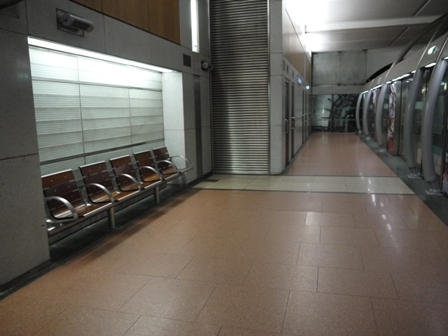
Platform in direction Olympiades. A small group of wooden and metal seats are placed in a recess.
Lit signage of Cour Saint-Émilion reset in a wall.
The station name is printed on white mixed case letter on a blue background.
Announcement display with the next two trains in the direction Olympiades.
It also prompts that everybody should be vigilant, not get separated from their bags and raise an alert if any packages are found abandonned.
Stairs from the platform to the upper level. The exit is marked with a blue sign 'Sortie'
The floor is tiled in polished stone tiles. In this section the majority of the tiles are light beige in colour.
- Details
The station opened on 19 July 1900.
It is situated in the 12th arrondissement. Gare de Lyon is served by the metro lines 1 and 14. Both have underground stations.
One of the platform entrances outside the station building.
The fence around the entrance is in the art nouveau style and painted green. Each panel has a flower design.
The lamppost at the side is green with a red sign with white capital letters showing the word 'METRO'. It is topped with a white, ball-shaped light.
The station sign is pained green with the station name pained in green on a yellow background.
In the panel is a map of the metro network.
The corridor from the entrance is tiled in very small white hexagonal tiles.
Colourful plastic strips have been placed half way up the wall and along the the corridor.
Further along the corridor, grey and orange hexagonal tiles have been added to the white tiles to form patterns.
Platform Line 1
Line 1 started operation on 19 July 1900.
The brick ceiling, which is painted white, consists of several small arches.
The ceiling is supported by steel girders and pillars painted yellow.
The lights are in yellow metal casings and hung from the ceiling.
The double pillars are supporting the steel beams and the ceiling. Each pillar is hexagonal.
They are joined at the top and decorated with patterns. This makes them look like bridges.
Yellow metal seats in the shape of half-bowls with a smiley have been fixed to the wall.
The ground is painted grey.
The walls are tiled in in large square white ceramic tiles.
The signage consists of mixed case white letters on a dark blue plasticised board.
Special free WIFI hotspots have been established on the platforms.
Platform Line 14
Line 14 started operation on 15 October 1998. It has a central platform with side tracks.
The floor is made of polished stone in different colours. The majority is pink. Grey floor tiles have been placed at the edge of the platform.
The track has been separated from the platform by platform barriers.
Some light has been placed above the platform barrier in white metal casings.
A small indoor garden has been installed behind the track.
Additional lighting has been provided over the centre platform.
The ceiling is straight with coloured panels.
- Details
The station opened on 10 December 1933.
Charonne is an underground station in the 11th arrondissement. It is served by the metro line 9.
The station takes its name from the castle Charonne.
The walls of the corridor are tiled until about head-height with white tiles. They are topped by a row of dark brown tiles with a flower pattern. The wall above and ceiling is is painted white.
The advertising frames in the corridor are surrounded by honey-coloured ceramic tiles. Their tops curve slightly on the painted part of the wall.
The station has two side platforms.
The vaulted ceiling is tiled.
Yellow plastic seats have been fixed to the wall just in front of the large advertising panels.
The edge of the platforms is painted white, followed by a row of grey tiles wilh raised circles.
Access to the platform is from the end.
The uplights reflect on the metal top.
The station name is burned in large upper-case white letters on rectangular blue ceramic tiles. The panel of 9 x 18 tiles is surrounded by a plain white frame made from ceramic tiles.
Underneath the main name is an additional small plasticised sign with white lettering: "Place du 8 février 1962". It marks the date when - during a demonstration to protest for Algerian independence - the police closed the surrounding streets and pushed the crowd down the metro. A number of demonstrators died during the fight.
Above the top centre of the advertising frame is a three part ceramic embellishment.
A spear-like centre is held up by two swirls with an open dahlia flower and a fuchsia flower each.
Detail of the ceramic frame. Large cabbage or spinach leaves are interspaced with slim tulip-like flowers. A row of raised circles separate them from the advertising.

